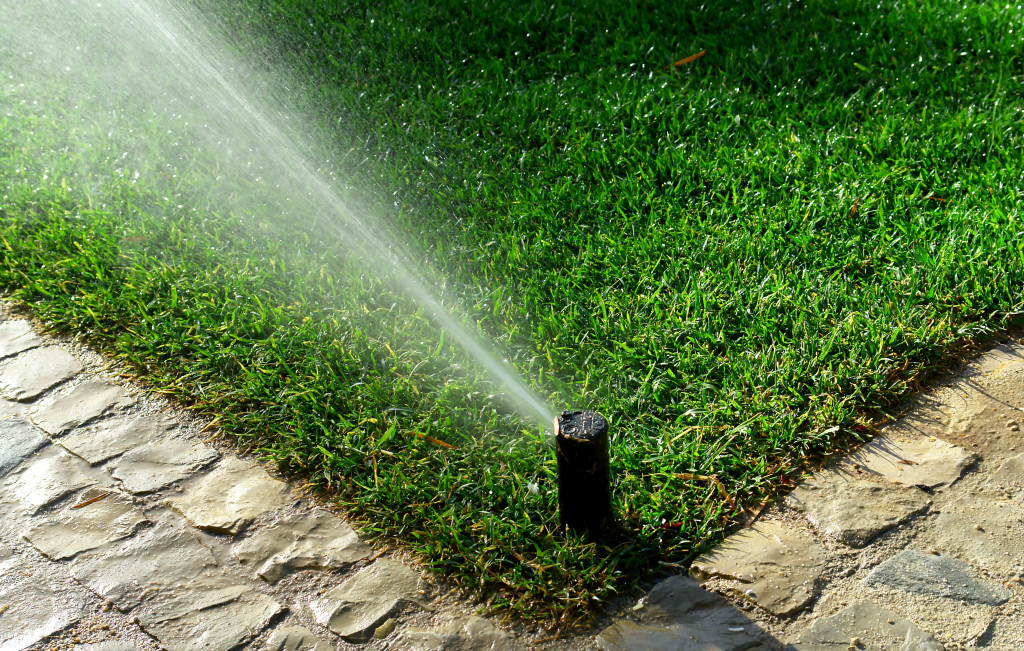 One of the best things a homeowner can do to promote a healthy and attractive lawn is to implement proper lawn watering practices. Weather conditions in the South Carolina Midlands can vary drastically from week to week, even day to day. Although afternoon thunderstorms and rain showers are common, this does not always provide adequate irrigation for lawns. These showers often produce heavy downpours and much of the water runs off before it is able to be absorbed by the soil.
One of the best things a homeowner can do to promote a healthy and attractive lawn is to implement proper lawn watering practices. Weather conditions in the South Carolina Midlands can vary drastically from week to week, even day to day. Although afternoon thunderstorms and rain showers are common, this does not always provide adequate irrigation for lawns. These showers often produce heavy downpours and much of the water runs off before it is able to be absorbed by the soil.
Seasonal droughts are also common in South Carolina and these extended periods of hot and dry weather can take their toll on residential lawns. Although warm-season turf varieties – which make up most of the lawns in and around Columbia – are more adapted to these extremes than cool-season grasses, it is usually necessary to provide your lawn with addition water. Be careful though. There is such a thing as too much water, and many people water far too frequently.
The healthiest and most efficient way to water your lawn is to allow the turf to dry out between watering sessions. Watering deeply and infrequently encourages a deeper and healthier root system and limits disease stress on your lawn. I’ve had many people tell me that they assumed a little bit of water every day was best for their grass. This may seem like a good way to reduce stress on your lawn, but it actually contributes to a weaker turf that is far more susceptible to damage from stresses like traffic, diseases, insects and drought.
If the surface of your lawn is constantly damp, the roots of your grass are never encouraged to grow deeper into the soil. A shallow-rooted lawn is not as durable as one with a deep and healthy root system. Furthermore, excess moisture on the surface of the grass for extended periods can promote disease outbreaks. The time of day when you run your irrigation system is also important, both for the health of your lawn and for your wallet. Water evaporation – and thus $ evaporation – is minimized during the early part of the day. Watering during early morning hours – between 4:00 – 8:00AM – is most efficient, and allows the surface of the lawn to dry during the day.
The amount of water that your lawn needs will vary, depending on things like soil type, slope, air movement, shade and grass type. Generally, most warm season lawns like Centipede, Zoysia, St. Augustine and Bermuda grass will require about 1 to 1.25 inches of water per week. It is usually best to apply about ½ an inch of water (sometimes slightly more) once every 3 or 4 days. Current weather conditions, as well as variations in soil type and density, and lack of shade may call for more water, so it is important to monitor the condition of your grass.
There are a number of ways to monitor your lawn’s need for water. Many times, grass will take on a blue-grey cast and the leaves will begin to roll when it is in need of water. Also, try walking across your lawn late in the day. If you leave footprints in the grass for an extended period and the grass does not spring back up, you should consider irrigating. One of the simplest tests is to try pressing a screwdriver into the soil. If it is difficult to press the screwdriver in at least an inch or so, it is probably time to water. Try using all of these simple tests together to monitor your lawn’s water needs.
By now, you might be thinking, “ok, I get it… deep and infrequent watering, about a half an inch every three days or so, water during the early morning hours, fine… but how do I know how much water I’m putting down?” People ask me all the time, “how long should I run my irrigation?” The answer is, it depends.
Every irrigation system is different, so you will need to determine how much water your sprinklers apply over a certain period of time. Here are some easy tips to help you calibrate your irrigation system so you can efficiently water your lawn:
- Collect straight-sided containers like tuna cans, coffee cans or wide rain gauges (3 to 6 inch diameter is best), and place containers randomly throughout one zone at a time.
- Run the irrigation for 15 minutes on the zone that you are testing.
- Collect the containers and pour the water into one container.
- Measure the water depth, then divide by the number of containers used. This is the average depth.
- Multiply the average water depth by 4 to determine the application rate per hour for that zone.
- Repeat this process for each of your zones. Now you know the irrigation rate for your system, and you will be able to water efficiently.
As always, Carolina Vistas is here to help. Please feel free to contact us with any questions!
[…] turf. Implementing a program that includes best management practices such as proper mowing and watering, balanced and turf-specific fertilization, soil testing and conditioning, insect and disease […]